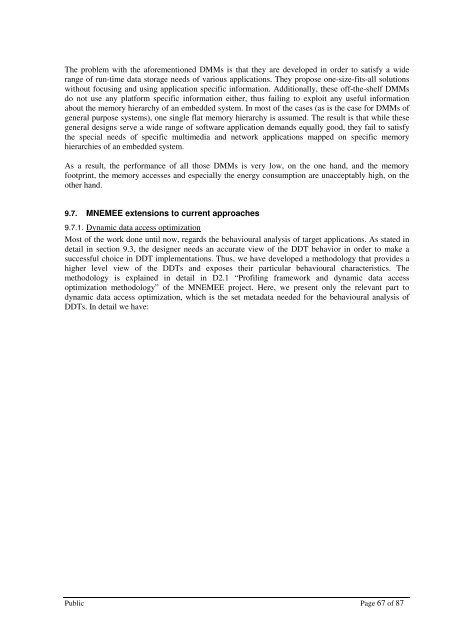MNEMEE - Electronic Systems - Technische Universiteit Eindhoven
MNEMEE - Electronic Systems - Technische Universiteit Eindhoven
MNEMEE - Electronic Systems - Technische Universiteit Eindhoven
Create successful ePaper yourself
Turn your PDF publications into a flip-book with our unique Google optimized e-Paper software.
The problem with the aforementioned DMMs is that they are developed in order to satisfy a wide<br />
range of run-time data storage needs of various applications. They propose one-size-fits-all solutions<br />
without focusing and using application specific information. Additionally, these off-the-shelf DMMs<br />
do not use any platform specific information either, thus failing to exploit any useful information<br />
about the memory hierarchy of an embedded system. In most of the cases (as is the case for DMMs of<br />
general purpose systems), one single flat memory hierarchy is assumed. The result is that while these<br />
general designs serve a wide range of software application demands equally good, they fail to satisfy<br />
the special needs of specific multimedia and network applications mapped on specific memory<br />
hierarchies of an embedded system.<br />
As a result, the performance of all those DMMs is very low, on the one hand, and the memory<br />
footprint, the memory accesses and especially the energy consumption are unacceptably high, on the<br />
other hand.<br />
9.7. <strong>MNEMEE</strong> extensions to current approaches<br />
9.7.1. Dynamic data access optimization<br />
Most of the work done until now, regards the behavioural analysis of target applications. As stated in<br />
detail in section 9.3, the designer needs an accurate view of the DDT behavior in order to make a<br />
successful choice in DDT implementations. Thus, we have developed a methodology that provides a<br />
higher level view of the DDTs and exposes their particular behavioural characteristics. The<br />
methodology is explained in detail in D2.1 “Profiling framework and dynamic data access<br />
optimization methodology” of the <strong>MNEMEE</strong> project. Here, we present only the relevant part to<br />
dynamic data access optimization, which is the set metadata needed for the behavioural analysis of<br />
DDTs. In detail we have:<br />
Public Page 67 of 87
















